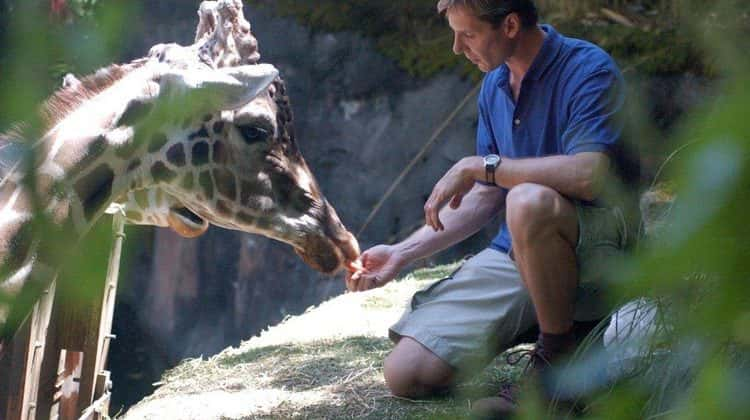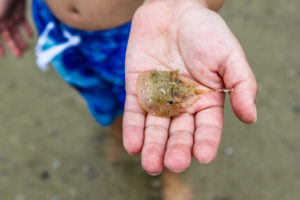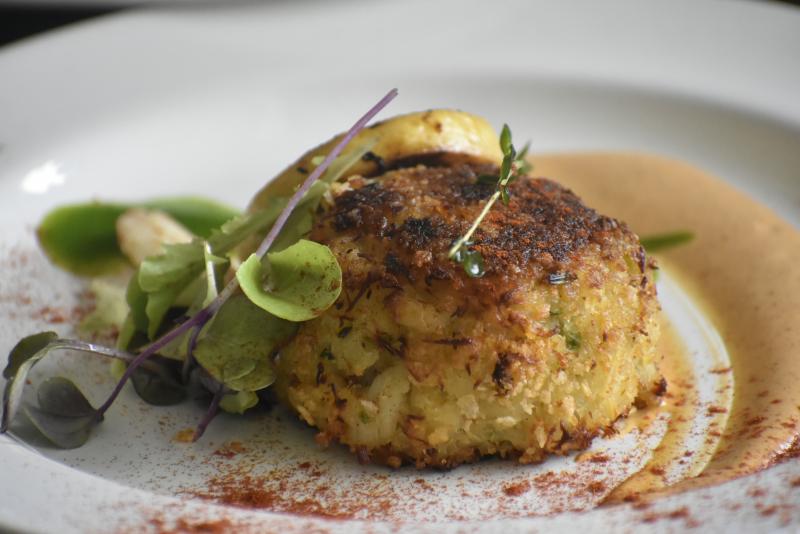
By Jim Knox

Equal parts kid-friendly and fascinating, the Horseshoe Crab is the perfect wild neighbor.
My happiest memories are family memories. Among them, water seemed to be our family theme, and the beach was our special place. Whether walking the edge of the salt marsh at Sherwood Island, swimming in Cape Cod Bay or wading the tidal creeks on the Cape’s Atlantic side, my wife, kids and I explored together. Frequently accompanied by their cousins, they would engage in a morning or afternoon of scanning, searching, digging, scooping and catching. Our rules were simple; empty shells, feathers and other natural items could be collected. Living creatures could be caught, briefly observed and gently released. This informal biological survey yielded amazing discoveries. Not a search would go by when the kids wouldn’t find a new variety of feather or shell, a new species of fish or a new sight concealed around the next bend of the salt marsh.
Among the myriad sea and marsh creatures we discovered together, one caught each child’s interest the moment they glimpsed one of the slow creatures making their way through the clear, shallow water. The distinctive tan, dinner-plate-sized creatures would move for deeper water or rapidly burrow into the soft sand to evade us. With careful guidance, the kids became expert at scooping up the multi-legged creatures before proudly displaying them for all to see.
The sea creatures they held aloft were new to them but were no newcomers to the beach. In fact, they’d been in the neighborhood for quite some time. The Atlantic Horseshoe Crab, (Limulus polyphemus) is the North American representative of the Horseshoe Crab family consisting of four related species found worldwide. These ancient creatures have been swimming the planet’s shallow seas for more than 450 million years! Our native Atlantic Horseshoe Crabs are the largest, reaching up to 24 inches in length, and range from Maine to the Yucatan Peninsula. Crabs in name only, Horseshoe Crabs are actually arthropods more closely related to spiders and scorpions. Thankfully, they lack the sting of their cousins. Their sharp spike of a tail, known as a telson, serves as a rudder and as a means to right themselves on land or water when they’re flipped.
With a protective, segmented exoskeleton, they search the shallow sandy seabed for mollusks, worms and other small invertebrates. They are versatile, using their five pairs of segmented legs for walking, swimming and placing food in their mouths. Their domed carapace, the prosoma, protects the animal’s brain, heart, mouth and legs. The smaller trailing section of the exoskeleton, the opisthosoma, shields the animal’s muscles and remarkable structures known as book gills. These organs enable the animal to breathe in both air and water and can also act as paddles, propelling the Horseshoe Crab through the water, upside down!
One of the keys to the Horseshoe Crab’s enduring success is it’s sensory array. Possessing a powerful pair of compound eyes (think dragonfly) which can magnify sunlight tenfold, they scan the surrounding waters for danger. When danger is detected they immediately burrow into the soft sand to completely disappear from sight within seconds. The crab boasts an impressive battery of seven other eyes including a pair of ventral eyes located near the mouth and even eyes which detect visible, polarized and ultraviolet light! In fact, much of what we know about human eyes was derived from the study of Horseshoe Crab eyes by Nobel Prize-winning scientist, Dr. Keffer Hartline.
You would think nine eyes and a pedigree of nearly half a billion years would catch our attention but the Horseshoe Crab has an even more attention-grabbing trait–blue blood. Possessing oxygen-carrying hemocyanin, instead of hemoglobin like us vertebrates, these ancient beasts owe the regal color of their blood to the copper in the hemocyanin, which produces the color. While blue blood is undeniably cool, there is something even cooler about this particular blood; it not only sustains life, it saves lives.
Their blood contains a compound known as Limulus Amebocyte Lysate–LAL for short. When exposed to bacterial toxins, LAL coagulates. This attribute has led to a medical breakthrough. Each year, medical researchers harvest Horseshoe Crab blood from millions of the animals (which can be performed without harming the animals) to create accurate tests to detect and prevent bacterial contamination on medical instruments, vaccines and other intravenous medicines. Held in such high esteem for their life-saving ability, Atlantic Horseshoe Crabs are a protected species.
In addition to being invaluable to our species, these timeless beasts contribute to the health of the ecosystem and their fellow species around them. With each female producing as many as 100,000 tiny green eggs each season, those that do not hatch provide food for countless other marine and terrestrial species, including many migratory birds. Those that do hatch will undergo a series of 18 or so molts over the course of a 20 year lifespan, marking them as some of the longest-living arthropods.
Equal parts kid-friendly and fascinating, the Horseshoe Crab is the perfect wild neighbor. I am so grateful for those days at the shore when time was not marked by minutes or hours but by the beaming smiles and laughter between the tides. Perhaps the greatest thing to emerge from our time at the beach was the discovery not of a new species, but of a species new to each one of our children, and along with it, knowing we were witness to something utterly timeless and inherently good, when our planet’s youngest learn from its oldest.
July 25, 2020 at 12:57AM
https://ift.tt/2OU6Gj9
Wildly Successful: The Atlantic Horseshoe Crab - Greenwich Sentinel
https://ift.tt/2MkGRbk
Crab

No comments:
Post a Comment